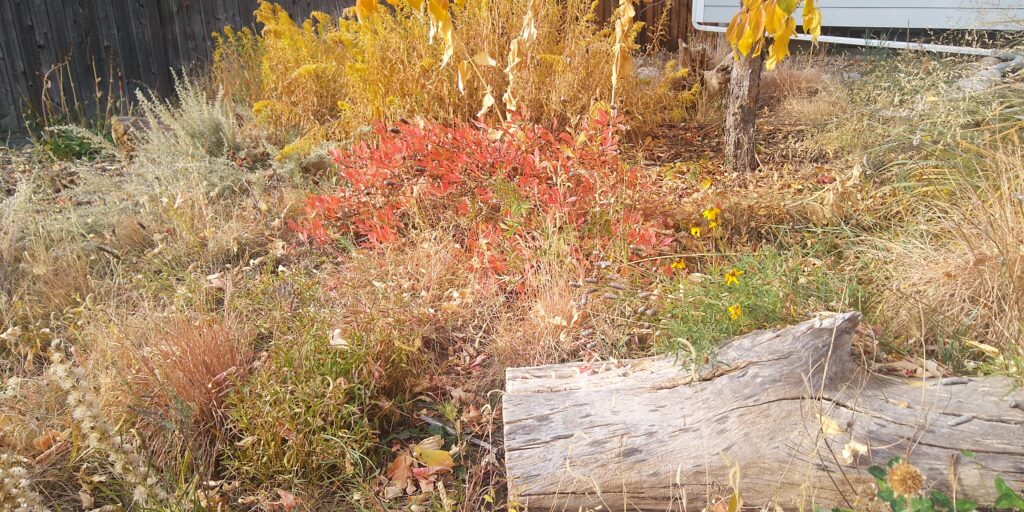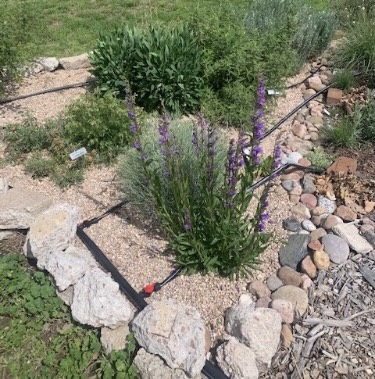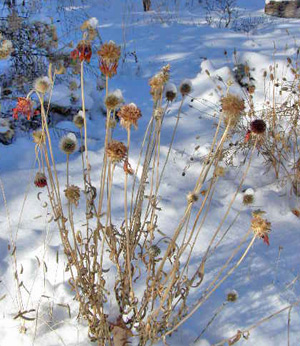Compiled by Deborah Lebow Aal
Bugs are in trouble, and our yards, both the plants we put in and the way we garden, can be part of the solution. The Xerces Society had an article I particularly liked on using your landscape to make a difference to bugs by adding microhabitats. I am summarizing and paraphrasing many of the good points that article made, here.
First and foremost, though, is the notion that all of us can make a difference to the plight of these tiny creatures, even if you have only a balcony or a tiny yard. Think about providing these three microhabitats to your space.

Leave Bare Space for Ground-Nesting Bees
Colorado has a whopping number of native bee species – up to 1,000 in a recent estimate. A majority of them require bare ground for nesting. So, leaving open bare patches, with few or no plants, is a good thing. And leaving thick mulch down is not leaving bare ground. Bees need to get to the soil easily. Using some native plants, grasses, or sedges that grow in clumps or bunches is a great solution to having space for bees but not leaving a completely bare area. And, don’t till or turn the soil in this area, once it’s established. The bees need the soil to remain stable. Fun fact: baby bees spend up to eleven months of the year underground.
I did already say don’t heavily mulch the area you’re leaving for ground-nesting bees, and maybe this is obvious, but don’t use plastic mulch, plastic grass, landscape fabric, or heavily treated or colored wood chips in this area. Impenetrable layers are just that; not good for ground-nesting bees. They will, however, do well in pea gravel, which they can easily get below, as well as compost, leaf litter, and plant debris. I particularly like the vision of ground nesting bees having a cozy home, burrowing under leaf litter.
So, how do you know those bees have arrived? Watch for small mounds of soil around a tunnel opening. And you’ll see those nesting mother bees making many trips bringing pollen back to the hole.
Provide Some Rocky Shelter
Many bugs like a rocky outcropping for shelter. Leaf cutter bees (Megachile spp.) make nests in the cracks or crevices of rocks. Other tunnel-nesting bees, such as digger bees (Anthrophora spp.) use water to soften sandstone and excavate it. Bumble bees (Bombas spp.) make homes in protected cavities inside rock piles and walls, while ground beetles (family Carabidae) and numerous other beneficial insects make their homes in gaps or burrows dug out from the soil under a stone.

Why rocks? Rocks are a great medium for shelter as they keep conditions beneath then relatively stable. On a dry, hot day, they keep the space below shaded, cool and damp. On a rainy day, bugs under rocks are likely to be dry. Rocks can help stabilize the body temperature of bugs, to stay warm when it’s cold out, and cool when it’s hot. Many bugs overwinter in rock cracks and crevices, and often bugs who build their own structures to live in, like to use rocks as an anchor.
If you have space to set aside for a rock pile, great. Use different types and sizes of rocks, with lots of spaces and crevices in between. If you want a sturdy foundation, dig a shallow hole in the ground and pile the rock on top. This provides a cave-like space for overwintering bugs. If possible, have several rock pile areas, some in the sun and some in the shade to give these little creatures different options. You can boost the quality of the habitats by incorporating native grasses and forbs nearby, for easy access to food and nesting materials.
A stone wall, or retaining wall, works well too. Use dry construction methods, that is, don’t fill the crevices and gaps with mortar. Let the bugs fill the holes in.
And, how do you know bugs are using your rock piles? You’ll begin to see little mounds of soil at the base of a rock from mining, leafcutter, and bumble bees. If you can check your rock piles at dawn or dusk, you ‘ll most likely see lots of activity from ground beetles and other night-time bugs. And, of course you’ll see evidence of spiders and perhaps jumping spiders on sunny rocks.
Leave Dead Plant Material

This one is easy – tidy up less! Fallen leaves, brush piles, stems, twigs, and old logs are such good material for pollinators. Many bugs take the leaves and recycle the leaf nutrients back into the soil. Others use leaves as a blanket to cozy into in the winter. So, find an area where you can keep some leaves over the winter, or spread them in your flower beds, and around your trees and shrubs. Don’t bag them off and send them to the landfill. I know we keep harping on this, but it is that important to helping insects survive. You can even keep a layer of leaves in a deck or balcony planter, to see a more diverse bug community come spring.
Leave the stems of your perennial plants. The seed heads will feed goldfinches and other birds, and the stems will provide some shelter. Some say plant stems are much healthier options than bee blocks or hotels. They break down naturally over time, avoiding diseases and pests. In the spring, you may be rewarded with stem-boring moths, carpenter bees and leaf-cutter bees, all beneficial insects (as most insects are!)
A brush pile in your “back 40” (I have a back 4 inches, which still works), can provide an area for hibernating butterflies, as well as nesting bees and wood-eating insects. And the brush pile will break down into gorgeous nutrient-rich soil or compost you can add to your yard.
Thanks to The Xerces Society for much of this information. Please visit xerces.org
